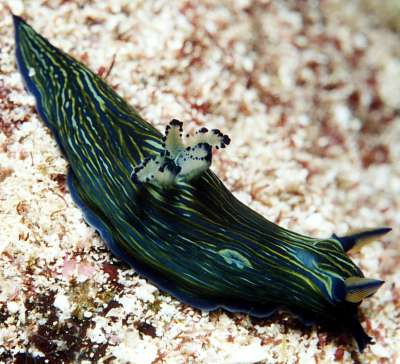
Roboastra leonis
Pola, Cervera & Gosliner, 2005
Order: NUDIBRANCHIA
Suborder: DORIDINA
Superfamily: ANADORIDOIDEA
Family: Polyceridae
Subfamily: Nembrothinae
DISTRIBUTION
Gulf of California to Galapagos Ids.
PHOTO
North Seymour Island, Galapagos Ids., July, 2003. 30-40 feet. Approx 30 mm long. Photo: Patty Dilworth
Body high and elongate with a long and pointed posterior end of the foot. There are numerous longitudinal lines of yellow ochre, green and bluish-black
on the notum and both sides of the body. Some of the lines are lighter in shade and can be continuous or broken. Pola et al describe the body surface as 'strongly wrinkled'. The edge of the foot is blue-black. The head is rounded with a pair of conical, completely retractile, perfoliate rhinophores
with approximately 40 tightly packed lamellae. The base of the rhinophores is blue-black with a similarly coloured core; while the rhinophore lamellae range from a pale yellowish colour to bright orange. The oral tentacles are strongly developed and enrolled - they are also blue-black.
There are five nonretractile tripinnate gills; the three anteriormost gills being larger than the others. The gills are white, with a blue-black tip to each leaflet giving each gill the appearance of being white with a dark blue edge. Pola et al describe a yellow line up the inner side of the rachis. The genital pore is dark blue and opens on the right side, midway between the gills and the rhinophores. Pola et al describe preserved animals measuring 25–80 mm in length.
This species is illustrated in A Field Guide to Marine Mollusks of the Galapagos by Cleveland Hickman Jr [1999 - p. 127 as Roboastra sp.].
"The edge of the foot is blue-black. The body is patterned with yellow ochre and blue-black stripes. The rhinophores are bright orange with blue-black at their bases and tips. The gills are white with blue-black tips." It is found in the Gulf of California and the Galapagos. It feeds on Tambja mullineri in the Galapagos and Tambja spp. in the Gulf. [See Ray Simpson's message].
Note added 21 July 2005: Previously known on Forum as Roboastra sp.2.
-
Pola, M.., Cervera, J.L. & Gosliner, T.M. (2005) Review of the systematics of the genus Roboastra Bergh, 1877 (Nudibranchia, Polyceridae, Nembrothinae) with the description of a new species from the Galápagos Islands. Zoological Journal of the Linnean Society,144, 167–189. With 12 figures
Rudman, W.B., 2005 (July 21) Roboastra leonis Pola, Cervera & Gosliner, 2005. [In] Sea Slug Forum. Australian Museum, Sydney. Available from http://www.seaslugforum.net/find/roboleon
Related messages
Roboastra leonis - Feeding behaviour
July 26, 2007
From: Alicia Hermosillo
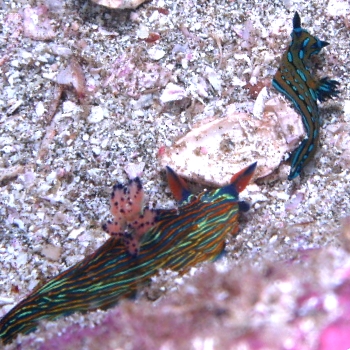
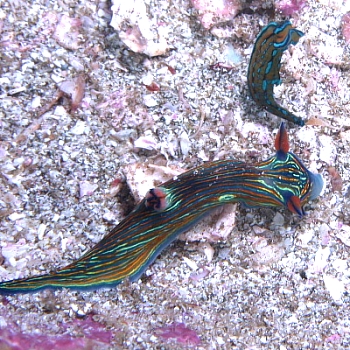
Concerning message #20283:
Dear Bill,
We observe similar behaviors on our side of the Pacific Ocean as well. We have two species of Roboastra: R. tigris and R. leonis (very appropiate!) and they do not overlap in range. R. tigris is known within the Gulf of California to Bahia de Banderas) and R. leonis from Costa Rica and the Galapagos, the gap in between needs more study to determine how far they are distributed.
In all this range, we have two of their preferred prey: Tambja abdere and Tambja eliora. They seem to like T. eliora more, since I have seen them spit out T. abdere more often than not. Now, T. eliora also has the swimming response observed by Graham in Tambja morosa, and I have seen it do so as soon as the Roboastra touches it. I have not seen it react to the mucus trail as Tambja morosa does, but it is certainly an interesting notion. I think this series of photos illustrates the escape response (attempt) of T. eliora to an attack by R. leonis.
Locality: Islas Murcielago, 36 feet, Costa Rica, tropical eastern Pacific, 3 July 2005, Rocky reef. Length: 29 mm. Photographer: Alicia Hermosillo.
Kind regards,
Ali
gueri25@hotmail.com
Hermosillo, A., 2007 (Jul 26) Roboastra leonis - Feeding behaviour. [Message in] Sea Slug Forum. Australian Museum, Sydney. Available from http://www.seaslugforum.net/find/20302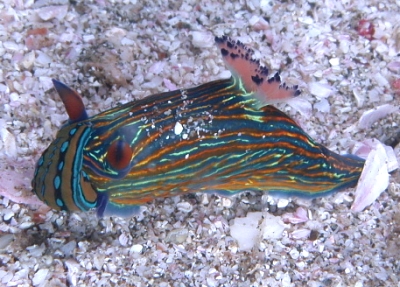
Dear Ali,
I thought this story had a happy ending for the Tambja until I saw its 'tail' flapping in the mouth of Roboastra in the photo alongside.
Your mention of an apparent preference for T. eliora is interesting as it fits the work of the chemical ecologists Carté and Faulkner (1983, 1986). Tambja eliora and T. abdere both feed on the bryozoan Sessibugula translucens which produce a whole suite of antifeedant chemicals including a group of molecules which have been given the name tambjamines for obvious reasons. Both species of Tambja retain these antifeedant chemicals in their skin. Carté and Faulkner studied Roboastra tigris feeding on these two species of Tambja and found that when attacked, T. abdere exuded copious quantities of a yellow mucus containing up to 3 mg of the tambjamines which was usually enough to deter the Roboastra. However they found that R. eliora, because of its smaller size, contained less than 2 mg of the tambjamines in its body so could not exude a strong enough deterrent dose of the tambjamines no matter how hard it tried, so to escape being eaten by Roboastra it relied on its swimming behaviour to escape.
Your observations fit this scenario perfectly and well illustrate how important it is for us to understand the food choices, and the resulting chemistry, when trying to interpret the behaviour and ecology of opisthobranchs.
-
Carté, B. and Faulkner, D. J. (1983) Defensive metabolites from three Nembrothid nudibranchs. Journal of Organic Chemistry, 48: 2314-2318.
-
Carté, B. and Faulkner, D. J. (1986) Role of secondary metabolites in feeding associations between a predatory nudibranch, two grazing nudibranchs, and a bryozoan. Journal of Chemical Ecology, 12: 795-804.
Best wishes,
Bill Rudman
Roboastra leonis from the eastern Pacific
July 22, 2005
From: Bill Rudman
As part of a concerted effort to tidy up some loose ends, I have just posted a Fact Sheet on Roboastra leonis from the eastern Pacific. This recently named species was formerly known on the Forum as Roboastra sp. 2
Best wishes,
Bill Rudman
Re: Roboastra tigris? from Galapagos
January 25, 2004
From: Ray Simpson
Note added 21 July 2005: This is now named Roboastra leonis
Regarding the Roboastra sp. from the Galapagos Ids in the recent message: It is shown in similar form in A Field Guide to Marine Mollusks of the Galapagos by Cleveland Hickman Jr [1999]. In this book, on pg. 127, it is called Roboastra sp. and is undescribed at the moment.
Here is the description from this book:
"The edge of the foot is blue-black. The body is patterned with yellow ochre and blue-black stripes. The rhinophores are bright orange with blue-black at their bases and tips. The gills are white with blue-black tips."
This seems identical to the pictured specimen. It is found in the Gulf of California and the Galapagos. It feeds on Tambja mullineri in the Galapagos and Tambja spp. in the Gulf.
Hope this helps...
Ray
P51MustNB@aol.com
Simpson, R., 2004 (Jan 25) Re: Roboastra tigris? from Galapagos. [Message in] Sea Slug Forum. Australian Museum, Sydney. Available from http://www.seaslugforum.net/find/12006Thanks Ray,
I wouldn't have been surprised if this animal had turned out to be a variant of Roboastra tigris but I guess if both forms live sympatrically in the Gulf of California it could be something separate.
Thanks for letting me know,
Bill Rudman
Roboastra tigris? from Galapagos
January 23, 2004
From: Patty Dilworth

Note added 21 July 2005: This is now named Roboastra leonis
Dear Dr. Rudman,
Sometimes, the more I look, the more confusing things get for slug identification! Thank you for your help with this one. I have sent a second similar looking species in a separate message. Both are from a dive at North Seymour Island in the Galapagos during the first week of July, 2003. Both types were quite numerous between 30-40 feet.
This one was approximately 30 mm long.
Patty Dilworth
Padilworth@aol.com
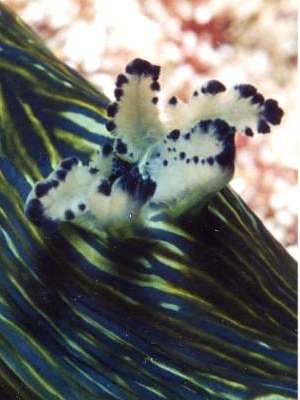
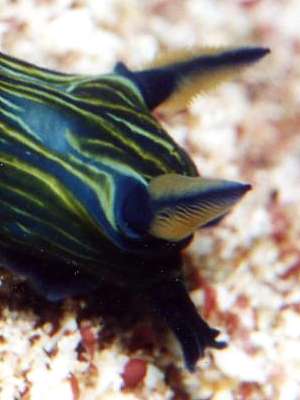
Dear Patty,
This is an interesting find. From the long tubular oral tentacles [see dark blue structure in lower right photo] this is a species of Roboastra which are voracious carnivores, well-known for feeding on relatives, such as species of Tambja. The only species I know of from the eastern Pacific is Robosastra tigris which has an ochre background colour and a few longitudinal blue bands outlined with thin pale yellowish lines. It is possible that your animal is a colour form with extra blue bands, but I think we would need to see some animals with an intermediate colour pattern for me to feel comfortable with that suggestion. However considering how little we know of these animals and their distribution in the eastern Pacific, the suggestion is definitely not out of the question. It wiuld be interesting to see if you could observe this animal feeding on other nudibranchs, in particular the Tambja in your other message.
I am certainly interested in seeing photos of any sea slugs you find in the Galapagos Ids. The marine fauna of the East Pacific is not well known so any records from the region, even of apparently common animals is valuable information.
Best wishes
Bill Rudman
